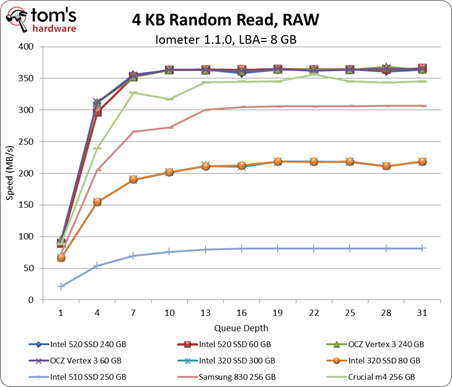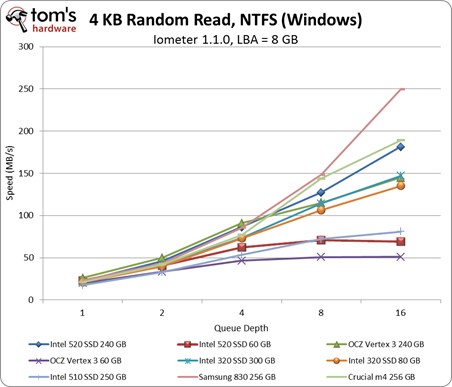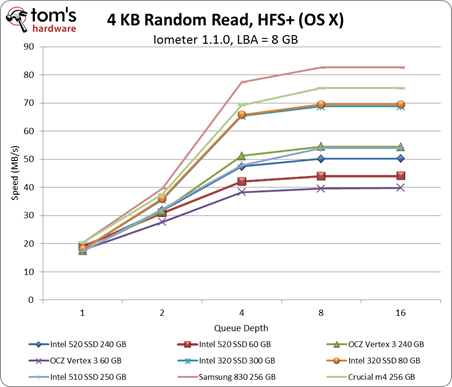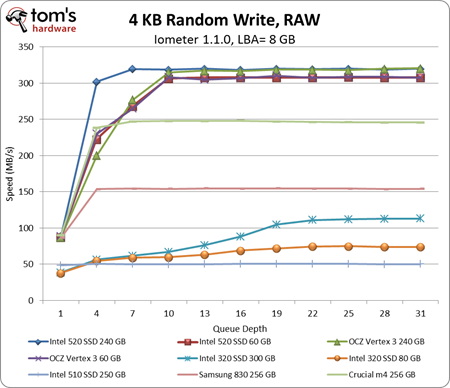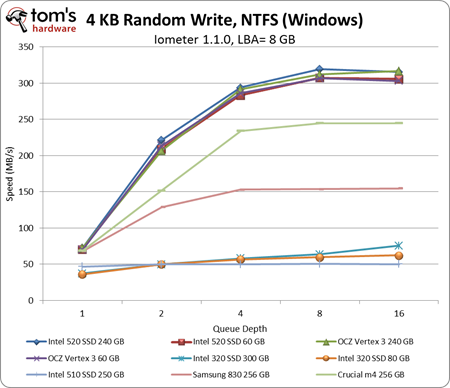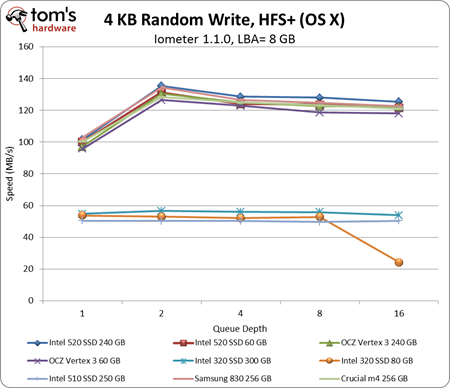Intel SSD 520 Review: Taking Back The High-End With SandForce
4 KB Random Performance: Raw, Windows, And Mac
Random Read Performance (background info)
Examples include antivirus scans and typing in Word
Although Intel quotes a slightly lower random read specification than OCZ, it certainly doesn't trail at all in our tests. At the physical level, Intel's SSD 520s are just as fast as the older Vertex 3s, which stand in here to represent the larger crowd of SandForce-based competition.
That's a good sign. SSDs based on SF-2281 typically lead the high-end market with aggressive random access results, By extension, Intel joins this pack. Even when we consider that most desktop workloads impose very low queue depths, the Intel drive still outperforms Crucial's m4 and Samsung's 830. Granted, 90% of the time your workload will remain at a queue depth of one. In that situation, you'll only experience a 10 MB/s lead over the m4 and 830. However, the rest of the time where you're stressing your storage system with more outstanding I/Os, you're going to enjoy a much larger performance delta. As the queue depth increases, the SandForce-based drives establish a more substantial advantage.
For Intel, though, the big story is the improvement over its SSD 510. Last year, the Marvell-based 510 emerged as the company's purported performance flagship. But although it centered on the same controller as Crucial's m4, Intel clearly prioritized sequential performance over random I/O. As a result, in the above graph, the SSD 510 lags way behind. In shifting to the SSD 520, Intel addresses write performance in a major way.
The performance overhead imposed by a file system seems to be pretty dramatic. We already established that the physical drive performance should start out at roughly 80-90 MB/s for the 256 GB m4, 256 GB 830, Vertex 3s, and SSD 520s, but that's not what we see here. Formatted, all of the SSDs start at roughly 20 MB/s.
Our Windows 7-based system returns relatively strong random read results. At a queue depth of eight, you're already able to push through the 100 MB/s barrier with performance-oriented SSDs like Intel's SSD 520. Not so on our MacBook Pro, where we're limited to sub-100 MB/s speeds.
Get Tom's Hardware's best news and in-depth reviews, straight to your inbox.
On our PC, in the chart above, the SSD 320s, 240 GB 520, 240 GB Vertex 3, 256 GB m4, and 256 GB 830 all perform as if in one fairly close group, while the slower 60 GB 520, 60 GB Vertex 3, and 250 GB SSD 510 trail off when there are more than eight outstanding I/Os. Samsung's 830 even takes a noticeable lead when you scale up to 16.
That's not the same trend observed on our Mac. While Samsung still leads, all of the SandForce-based drives start to fall behind at higher queue depths. In a twist, we even see both SSD 320s outperform the 520s and Vertex 3s.
Random Write Performance
Examples include email, file compression, and Web browsing
Random write performance looks similar to random reads. At a queue depth of one, the latest SATA 6Gb/s SSDs hit the same ~90 MB/s ceiling. Only the SSD 510 and 320s perform noticeably slower. Once you scale up, though, things get more interesting.
While SandForce-based SSDs generally trend toward the top, Intel's 240 GB SSD 520 deserves praise for punching through the 300 MB/s barrier at only four outstanding I/O operations. Crucial's 256 GB m4 tops out at 250 MB/s, falling 50 MB/s short of SandForce-based pack. The real disappointment here is Samsung's 256 GB 830, which plateaus at ~150 MB/s.
Our Mac and PC systems produce vastly different results. Like random reads, our Windows 7-based PC seems much better suited for random writes. The results largely mirror what we see for physical block level testing.
In contrast, the results from our MacBook Pro reflect significantly less performance. Even at a queue depth of 16, we can't seem to punch through the 140 MB/s barrier. As a result, we see a very tight grouping. Intel's SSD 520s, OCZ's Vertex 3s, Crucial's 256 GB m4, and Samsung's 256 GB 830 are all lumped together without any perceivable difference.
Current page: 4 KB Random Performance: Raw, Windows, And Mac
Prev Page Breaking Out New Benchmarks Next Page 128 KB Sequential Performance: Raw, Windows, And Mac-
phamhlam I love Intel SSD. 128GB for about $210 isn't bad. It is just hard to not chose something like a Corsair GT 120GB that cost $150 with rebate over this. I would always put a Intel SSD in a computer for novice since it is reliable.Reply -
jaquith Nice article :)Reply
Just need more SSD's to compare, I'd like to see similar tests done with 120GB...180GB...256GB and several more brands. Further, as I mentioned before in the other article please list the exact model numbers and OEM specs including their 4KB IOPS; otherwise folks don't understand the results and if relying on this a purchasing will have in many cases a 4 in 5 chance of selecting the wrong SSD.
Prior article - http://www.tomshardware.com/reviews/sata-6gbps-performance-sata-3gbps,3110.html -
theuniquegamer costly but i think reliability comes at a price. These ssds are best for enterprises . If the price will be little lower then the common user can afford these and get a good reliable ssd.Reply -
bildo123 "Measuring boot time is one of the best illustrations of how an SSD benefits your computing experience." Be that as it may I find it almost irrelevant seeing as I hardly ever boot my computer, perhaps 2-3 times a month if that. Getting out of standby on my HDD is a matter of seconds.Reply -
danraies These prices are lower than I thought. $20-$40 extra (depending on the comparison) for peace-of-mind is not outrageous.Reply -
acku carn1xHmmm, maybe I missed a good excuse, but I'd like to see the Octane in these tests.Reply
We didn't have the Octane on hand in the 256 GB capacity, but we'll be sure to make that side by side comparison down the road.
phamhlamI love Intel SSD. 128GB for about $210 isn't bad. It is just hard to not chose something like a Corsair GT 120GB that cost $150 with rebate over this. I would always put a Intel SSD in a computer for novice since it is reliable.
Excellent point. Price is always a fickle thing.
thessdreviewNice Review!Thanks Les. :)
jaquithNice article Just need more SSD's to compare, I'd like to see similar tests done with 120GB...180GB...256GB and several more brands. Further, as I mentioned before in the other article please list the exact model numbers and OEM specs including their 4KB IOPS; otherwise folks don't understand the results and if relying on this a purchasing will have in many cases a 4 in 5 chance of selecting the wrong SSD. Prior article - http://www.tomshardware.com/review ,3110.html
We'll keep that mind for future reviews. However, we already list model and firmware on the test page.
Cheers,
Andrew Ku
TomsHardware.com
-
willard bildo123Getting out of standby on my HDD is a matter of seconds.And with an SSD, your computer comes out of standby faster than your monitors do. Not kidding.Reply -
mrkdilkington Anyone else disappointed Intel isn't producing their own high end chipset? Been waiting to upgrade my X25-M for a while now (Intel 320 isn't a big upgrade) but might just go with Samsung.Reply
